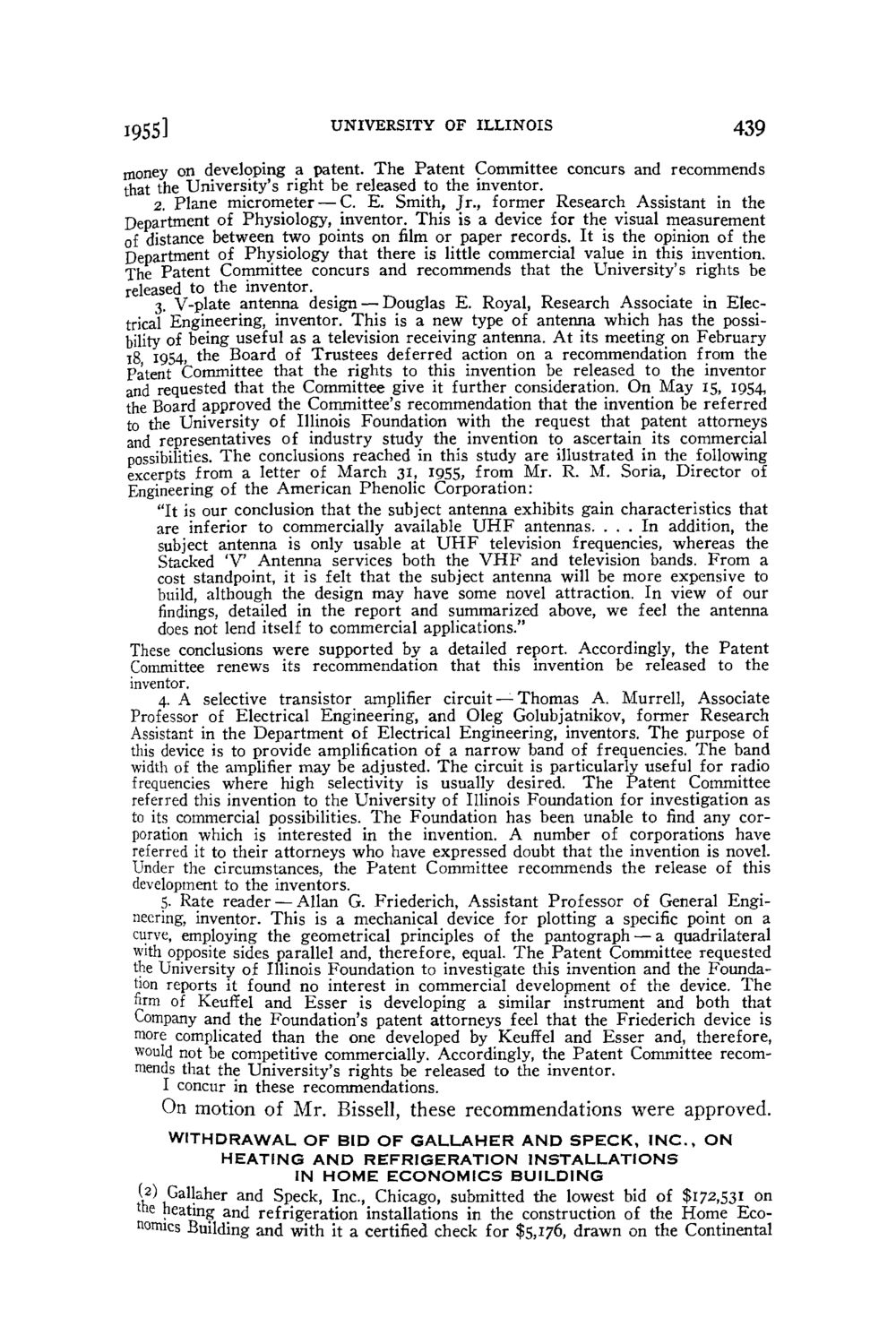| |
| |
Caption: Board of Trustees Minutes - 1956
This is a reduced-resolution page image for fast online browsing.

EXTRACTED TEXT FROM PAGE:
19551 UNIVERSITY OF ILLINOIS 439 money on developing a patent. The Patent Committee concurs and recommends that the University's right be released to the inventor. 2. Plane micrometer — C. E. Smith, Jr., former Research Assistant in the Department of Physiology, inventor. This is a device for the visual measurement of distance between two points on film or paper records. It is the opinion of the Department of Physiology that there is little commercial value in this invention. The Patent Committee concurs and recommends that the University's rights be released to the inventor. 3. V-plate antenna design — Douglas E. Royal, Research Associate in Electrical Engineering, inventor. This is a new type of antenna which has the possibility of being useful as a television receiving antenna. At its meeting on February jg 1954, the Board of Trustees deferred action on a recommendation from the Patent Committee that the rights to this invention be released to the inventor and requested that the Committee give it further consideration. On May IS, 1954 the Board approved the Committee's recommendation that the invention be referred to the University of Illinois Foundation with the request that patent attorneys and representatives of industry study the invention to ascertain its commercial possibilities. T h e conclusions reached in this study are illustrated in the following excerpts from a letter of March 31, 1955, from Mr. R. M. Soria, Director of Engineering of the American Phenolic Corporation: "It is our conclusion that the subject antenna exhibits gain characteristics that are inferior to commercially available U H F antennas. . . . In addition, the subject antenna is only usable at U H F television frequencies, whereas the Stacked 'V' Antenna services both the V H F and television bands. From a cost standpoint, it is felt that the subject antenna will be more expensive to build, although the design may have some novel attraction. In view of our findings, detailed in the report and summarized above, we feel the antenna does not lend itself to commercial applications." These conclusions were supported by a detailed report. Accordingly, the Patent Committee renews its recommendation that this invention be released to the inventor. 4. A selective transistor amplifier circuit — Thomas A. Murrell, Associate Professor of Electrical Engineering, and Oleg Golubjatnikov, former Research Assistant in the Department of Electrical Engineering, inventors. The purpose of this device is to provide amplification of a narrow band of frequencies. The band width of the amplifier may be adjusted. The circuit is particularly useful for radio frequencies where high selectivity is usually desired. The Patent Committee referred this invention to the University of Illinois Foundation for investigation as to its commercial possibilities. The Foundation has been unable to find any corporation which is interested in the invention. A number of corporations have referred it to their attorneys who have expressed doubt that the invention is novel. Under the circumstances, the Patent Committee recommends the release of this development to the inventors. 5. Rate reader — Allan G. Friederich, Assistant Professor of General Engineering, inventor. This is a mechanical device for plotting a specific point on a curve, employing the geometrical principles of the pantograph — a quadrilateral with opposite sides parallel and, therefore, equal. The Patent Committee requested the University of Illinois Foundation to investigate this invention and the Foundation reports it found no interest in commercial development of the device. The firm of Keuffel and Esser is developing a similar instrument and both that Company and the Foundation's patent attorneys feel that the Friederich device is more complicated than the one developed by Keuffel and Esser and, therefore, would not be competitive commercially. Accordingly, the Patent Committee recommends that the University's rights be released to the inventor. I concur in these recommendations. On motion of Mr. Bissell, these recommendations were approved. WITHDRAWAL OF BID OF GALLAHER AND SPECK, I N C . , O N HEATING A N D REFRIGERATION INSTALLATIONS IN HOME ECONOMICS BUILDING 2 (, ) Gallaher and Speck, Inc., Chicago, submitted the lowest bid of $172,531 on 'he heating and refrigeration installations in the construction of the Home Economics Building and with it a certified check for $5,176, drawn on the Continental
| |